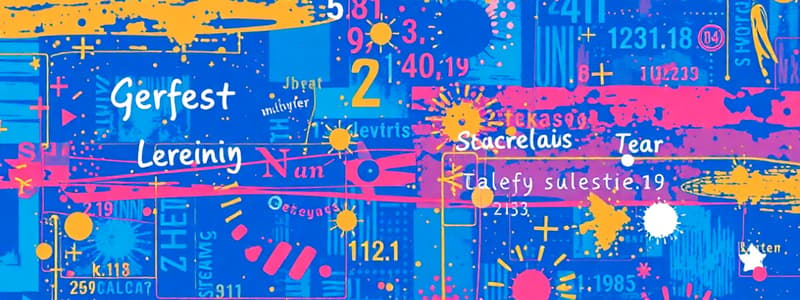Podcast
Questions and Answers
What is the main idea behind weak supervision?
What is the main idea behind weak supervision?
- To use hand-labeled data instead of heuristics.
- To rely on a small amount of hand-labeled data to guide the development of heuristics.
- To develop heuristics based on subject matter expertise to label data. (correct)
- To use algorithms that can learn from noisy data without human intervention
What is a labeling function (LF)?
What is a labeling function (LF)?
- A function that measures the accuracy of a machine learning model.
- A function that assigns labels to data based on pre-defined rules or heuristics. (correct)
- A function that generates new data samples for training a machine learning model.
- A function that automatically labels data using machine learning algorithms.
What is the key challenge associated with using labeling functions (LFs)?
What is the key challenge associated with using labeling functions (LFs)?
- LFs can be computationally expensive to execute.
- LFs are limited to a specific type of data.
- LFs can produce noisy and conflicting labels. (correct)
- LFs are too complex to implement efficiently.
Which of the following is NOT an example of a heuristic that can be encoded as a labeling function?
Which of the following is NOT an example of a heuristic that can be encoded as a labeling function?
Why is it important to combine and denoise labeling functions (LFs)?
Why is it important to combine and denoise labeling functions (LFs)?
Why is a small amount of hand-labeled data recommended for weak supervision?
Why is a small amount of hand-labeled data recommended for weak supervision?
What is the primary advantage of programmatic labeling over hand labeling?
What is the primary advantage of programmatic labeling over hand labeling?
What is the advantage of weak supervision when data has strict privacy requirements?
What is the advantage of weak supervision when data has strict privacy requirements?
What is a potential limitation of weak supervision?
What is a potential limitation of weak supervision?
What is one reason why ML models are still needed even though LFs can be used to label data?
What is one reason why ML models are still needed even though LFs can be used to label data?
What is the term used to describe the approach of using LFs to generate labels for data?
What is the term used to describe the approach of using LFs to generate labels for data?
What is one way that weak supervision can be used to improve the performance of ML models?
What is one way that weak supervision can be used to improve the performance of ML models?
How does programmatic labeling address the issue of privacy when labeling data?
How does programmatic labeling address the issue of privacy when labeling data?
What is one benefit of being able to reuse LFs across tasks?
What is one benefit of being able to reuse LFs across tasks?
What is one limitation of weak supervision?
What is one limitation of weak supervision?
What does Figure 4-5 show about the performance of models trained with weak supervision?
What does Figure 4-5 show about the performance of models trained with weak supervision?
Flashcards
Label Functions (LFs)
Label Functions (LFs)
Algorithms that generate labels for datasets based on a small subset of data.
Programmatic Labeling
Programmatic Labeling
An approach that uses LFs to create labels efficiently without manual labeling.
Advantages of Programmatic Labeling
Advantages of Programmatic Labeling
Cost-saving, adaptive, and maintains privacy compared to hand labeling.
Weak Supervision
Weak Supervision
Signup and view all the flashcards
Data Privacy in Programmatic Labeling
Data Privacy in Programmatic Labeling
Signup and view all the flashcards
Adaptive Labeling
Adaptive Labeling
Signup and view all the flashcards
Model Performance Comparison
Model Performance Comparison
Signup and view all the flashcards
Noisy Labels
Noisy Labels
Signup and view all the flashcards
Labeling function (LF)
Labeling function (LF)
Signup and view all the flashcards
Heuristics
Heuristics
Signup and view all the flashcards
Snorkel
Snorkel
Signup and view all the flashcards
Noise in labels
Noise in labels
Signup and view all the flashcards
Combining LFs
Combining LFs
Signup and view all the flashcards
Denoising
Denoising
Signup and view all the flashcards
Privacy in data
Privacy in data
Signup and view all the flashcards
Study Notes
Weak Supervision Overview
- Weak supervision avoids manual labeling, using heuristics instead.
- Snorkel, an open-source tool, is popular for weak supervision.
- Experts use heuristics (rules of thumb) to label data.
Labeling Functions (LFs)
- LFs encode heuristics to label data.
- Examples of heuristics: keyword matching, regular expressions, database lookups, and outputs from other models.
- LFs are noisy due to heuristic nature.
Combining and Improving LFs
- Multiple LFs may label the same data differently (conflicting).
- Combining, denoising, and reweighting LFs are vital for accuracy.
- A small number of manually labeled examples help assess LF accuracy.
Advantages of Programmatic Labeling
- Cost savings: Expertise can be reused and shared across teams.
- Privacy: Uses a smaller subset of data for heuristic creation.
- Speed: Scales easily to large datasets.
- Adaptability: Easily adaptable to data changes by reapplying LFs.
Case Study: Weak Supervision in Practice
- Stanford study shows similar model performance with weak supervision and extensive manual data labeling.
- Models improved with more unlabeled data.
- Heuristics (LFs) were reused across different tasks.
Combining LFs with ML Models
- LFs might miss some data points.
- ML models are trained on data labeled by LFs for broader coverage.
- ML models predict for cases not covered by heuristics.
Limitations of Weak Supervision
- Labels from weak supervision might be too noisy.
- It's not always sufficient for complex cases.
- Useful for initial explorations before extensive manual labeling.
Studying That Suits You
Use AI to generate personalized quizzes and flashcards to suit your learning preferences.




